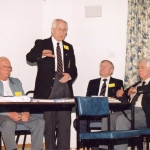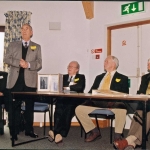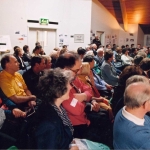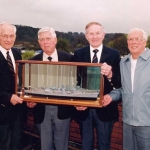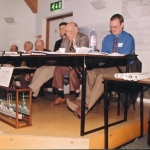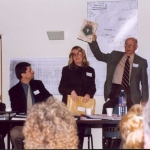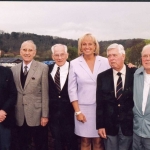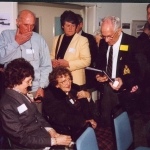Around one hundred and sixty people gathered at the Leichlingen Pavilion in Henley-on-Thames on 7th April 2001 for the first ever HMS Dunedin Reunion. The following is the text of the report of the meeting published in Navy News.
FORGOTTEN HORROR OF THE DUNEDIN
At one of the most poignant of Naval reunions, the last four known survivors of a World War II sea tragedy have met again for the first time in 60 years.
They were among just 67 men who lived to tell the tale of the death of HMS Dunedin, a light cruiser with a complement of nearly 500 that was sunk in shark-infested waters in 1941.
However, their meeting in Henley was far from sparsely attended: it brought in 160 – relatives and friends of the lost men and survivors, as well as those who had served in the Plymouth-based ship before her last deployment. The attendance thrilled the organisers – Lt Cdr Chris Broadway RN (retd), Daniel Morgan (whose fathers were lost with the cruiser) and Stuart Gill, son of one of those who survive today.
Of the survivors, William Gill was a Royal Marine, Jim Davis and Harry Cross ABs, and Les Barter a boy seaman. They have become the nucleus of a newly formed Dunedin Society dedicated to filling a gap in the history books.
Lt Cdr Broadway’s father, Lt Cdr Harold Broadway, was the Dunedin’s Principal Medical Officer when she was torpedoed by a U-boat in mid-South Atlantic off St Paul’s Rocks. Daniel Morgan’s father was her executive officer.
Over half the ship’s company are estimated to have survived the actual sinking. But that was only the beginning of their terrible ordeal. Dunedin went down at 1.20pm on November 24 son after she had made her routine position-course-speed signal. She may have had time to send off a distress call, but it was never picked up, and it was another 24 hours before the Royal Navy realised she was missing.
The nearest British Warship was about 1,000 miles away, the nearest proper land at least 1,200 miles distant – and the Dunedin had been sunk far from the main shipping lanes. Rescue seemed hopeless.
The 250 or so men in the water suffered horrifically. The dwindling group endured four days under the tropical sun, clinging to any flotsam they could find. To add to their distress they were plagued by marine predators that hunted in the St Paul’s Rocks area.
First they were attacked by sharks – there were very many – then by small but voracious black durgon fish, a sort of salt-water piranha that can take a square-inch of flesh from a man with one bite.
Finally they had to endure further agonies as a huge shoal of poisonous man-o’-war jellyfish drifted among them.
One by one they were dying and their hopes fading. But by sheer luck a US freighter, the Nishmaha, had suffered engine failure in the area and while the crew worked desperately to get her going she drifted well outside the shipping lanes.
When she did get under way gain she was far off course – but by a stroke of amazing good fortune for the Dunedin survivors, she headed straight for their position.
By the time the ship spotted them there were only 72 left alive, five of whom died within 24 hours of being rescued.
The story of the Dunedin remains largely untold – partly, perhaps, because the crew’s horrific fate was too fearful to be detailed, even to a public which by 1941 had become inured to news of losses and disasters. Partly, too. because the sinking was overshadowed by the Japanese attack on Pearl Harbor which took place as the survivors were reaching safety.
Now Stuart Gill is writing a book to coincide with the 60th anniversary of the tragedy. At the reunion he said: “When I consider how little we knew about Dunedin when we started this project it is truly wonderful to see so many people here to pay their respects and to keep alive the memory of those who died”.
Here are a few images from the day :-
